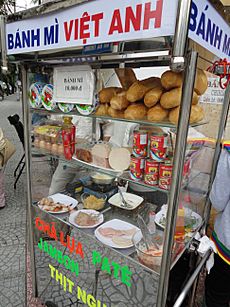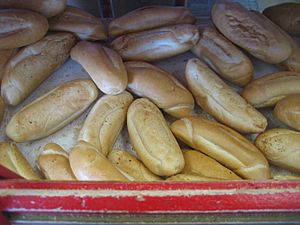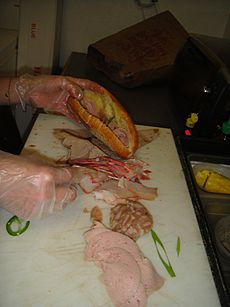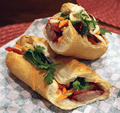Bánh mì facts for kids
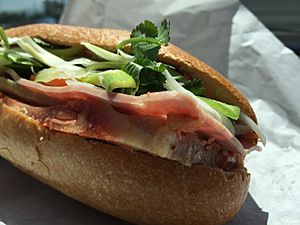
A bánh mì thịt nguội prepared in San Jose, California
|
|
| Alternative names | Vietnamese roll or sandwich, Saigon roll or sandwich |
|---|---|
| Type | Sandwich |
| Place of origin | Vietnam |
| Invented | 1950s |
| Main ingredients | Vietnamese baguette (also called bánh mì) |
| Variations | See below |
In Vietnamese cuisine, Bánh mì or banh mi ( "bread") is a short baguette with thin, crisp crust and soft, airy texture. It is often split lengthwise and filled with savory ingredients like a submarine sandwich and served as a meal. Plain banh mi is also eaten as a staple food.
A typical Vietnamese roll or sandwich is a fusion of meats and vegetables from native Vietnamese cuisine such as chả lụa (pork sausage), coriander leaf (cilantro), cucumber, pickled carrots, and pickled daikon combined with condiments from French cuisine such as pâté, along with chili and buttery mayonnaise. However, a wide variety of popular fillings are used, from xíu mại to ice cream. In Vietnam, bread rolls and sandwiches are typically eaten for breakfast or as a snack.
The baguette was introduced to Vietnam in the mid-19th century, when Vietnam was part of French Indochina, and became a staple food by the early 20th century. During the 1950s, a distinctly Vietnamese style of sandwich developed in Saigon, becoming a popular street food, also known as bánh mì Sài Gòn ("Saigon sandwich", "Saigon-style banh mi"). Following the Vietnam War, Overseas Vietnamese popularized the bánh mì sandwich in countries such as Australia, Canada and the United States. In these countries they are commonly sold in Asian bakeries.
Contents
Terminology
In Vietnamese, the word bánh mì is derived from bánh (which can refer to many kinds of food, primarily baked goods, including bread) and mì (wheat). It may also be spelled bánh mỳ in northern Vietnam. Taken alone, bánh mì means "bread", but particularly the Vietnamese baguette, or the sandwich made from it.
A folk etymology claims that the word bánh mì is a corruption of the French pain de mie, meaning soft, white bread. However, bánh or its Nôm form 餅 has referred to rice cakes and other pastries since as early as the 13th century, centuries before French contact.
Many restaurateurs, chefs, and food companies unfamiliar with the term misunderstand bánh mì to refer to the fillings (particularly the pickled radish and carrot) rather than the bread and sandwich, resulting in the term being incorrectly applied to bowls, soups, salads, and other inapplicable foods.
History
The word bánh mì, meaning "bread", is attested in Vietnamese as early as the 1830s, in Jean-Louis Taberd's dictionary Dictionarium Latino-Annamiticum. French colonists introduced Vietnam to the baguette, along with other baked goods such as pâté chaud, in the 1860s, when Vietnam was part of French Indochina. Northern Vietnamese initially called the baguette bánh tây, literally "Western bánh", while Southern Vietnamese called it bánh mì, "wheat bánh". Nguyễn Đình Chiểu mentions the baguette in his 1861 poem "Văn tế nghĩa sĩ Cần Giuộc". Due to the price of imported wheat at the time, French baguettes and sandwiches were considered a luxury. During World War I, an influx of French soldiers and supplies arrived. At the same time, disruptions of wheat imports led bakers to begin mixing in inexpensive rice flour (which also made the bread fluffier). As a result, it became possible for ordinary Vietnamese to enjoy French staples such as bread. Many shops baked twice a day, because bread tends to go stale more quickly in the Vietnamese climate. Baguettes were mainly eaten for breakfast with some butter and sugar.
Until the 1950s, sandwiches hewed closely to French tastes, typically a jambon-beurre moistened with a mayonnaise or liver pâté spread. The 1954 Partition of Vietnam sent over a million migrants from North Vietnam to South Vietnam, transforming Saigon's local cuisine. Among the migrants were Lê Minh Ngọc and Nguyễn Thị Tịnh, who opened a small bakery named Hòa Mã in District 3. In 1958, Hòa Mã became one of the first shops to sell bánh mì thịt. Around this time, another migrant from the North began selling chả sandwiches from a basket on a mobylette, and a stand in Gia Định Province (present-day Phú Nhuận District) began selling phá lấu sandwiches. Some shops stuffed sandwiches with inexpensive Cheddar cheese, which came from French food aid that migrants from the North had rejected. Vietnamese communities in France also began selling bánh mì.
After the Fall of Saigon in 1975, bánh mì sandwiches became a luxury item once again. During the so-called "subsidy period", state-owned phở eateries often served bread or cold rice as a side dish, leading to the present-day practice of dipping quẩy in phở. In the 1980s, Đổi Mới market reforms led to a renaissance in bánh mì, mostly as street food.
Meanwhile, Vietnamese Americans brought bánh mì sandwiches to cities across the United States. In Northern California, Lê Văn Bá and his sons are credited with popularizing bánh mì among Vietnamese and non-Vietnamese Americans alike through their food truck services provider and their fast-food chain, Lee's Sandwiches, beginning in the 1980s. Sometimes bánh mì was likened to local sandwiches. In New Orleans, a "Vietnamese po' boy" recipe won the 2009 award for best po' boy at the annual Oak Street Po-Boy Festival. A restaurant in Philadelphia also sells a similar sandwich, marketed as a "Vietnamese hoagie".
Bánh mì sandwiches were featured in the 2002 PBS documentary Sandwiches That You Will Like. The word bánh mì was added to the Oxford English Dictionary on 24 March 2011. As of 2017, bánh mì is included in about 2% of U.S. restaurant sandwich menus, a nearly fivefold increase from 2013. On March 24, 2020, Google celebrated Bánh mì with a Google Doodle.
Ingredients
Bread
A Vietnamese baguette has a thin crust and white, airy crumb. It may consist of both wheat flour and rice flour.
Besides being made into a sandwich, it is eaten alongside meat dishes, such as bò kho (a beef stew), curry, and phá lấu. It can also be dipped in condensed milk (see Sữa Ông Thọ).
Fillings
A bánh mì sandwich typically consists of one or more meats, accompanying vegetables, and condiments.
Accompanying vegetables typically include fresh cucumber slices, cilantro (leaves of the coriander plant) and pickled carrots and white radishes in shredded form (đồ chua). Common condiments include spicy chili sauce, sliced chilis, Maggi seasoning sauce, and mayonnaise.
Varieties
Many fillings are used. A typical bánh mì shop in the United States offers at least 10 varieties.
The most popular variety is bánh mì thịt, thịt meaning "meat". Bánh mì thịt nguội (also known as bánh mì pâté chả thịt, bánh mì đặc biệt, or "special combo") is made with various Vietnamese cold cuts, such as sliced pork or pork belly, chả lụa (pork sausage), and head cheese, along with the liver pâté and vegetables like carrot or cucumbers.
Other varieties include:
- Bánh mì bì (shredded pork sandwich) – shredded pork or pork skin, doused with fish sauce
- Bánh mì chà bông (pork floss sandwich)
- Bánh mì xíu mại (minced pork meatball sandwich) – smashed pork meatballs
- bánh mì thịt nguội (ham sandwich)
- Bánh mì cá mòi (sardine sandwich)
- Bánh mì pa-tê (pâté sandwich)
- Bánh mì xá xíu or bánh mì thịt nướng (barbecue pork sandwich)
- Bánh mì chả lụa or bánh mì giò lụa (pork sausage sandwich)
- Bánh mì gà nướng (grilled chicken sandwich)
- Bánh mì chay (vegetarian sandwich) – made with tofu or seitan; in Vietnam, usually made at Buddhist temples during special religious events, but uncommon on the streets
- Bánh mì chả cá (fish patty sandwich)
- Bánh mì bơ (margarine or buttered sandwich) – margarine / butter and sugar
- Bánh mì trứng ốp-la (fried egg sandwich) – contains fried eggs with onions, sprinkled with soy sauce, sometimes buttered; served for breakfast in Vietnam
- Bánh mì kẹp kem (ice cream sandwich) – contains scoops of ice cream topped with crushed peanuts
-
Bánh mì bì (shredded pork sandwich) at Eden Center
-
Bánh mì xíu mại (minced pork meatball sandwich)
Nowadays, it is popular with different type of bánh mì : bánh mì que. Its shape is thinner and longer than a normal one. But it can be fulfilled with different ingredients as normal bánh mì.
Sandwices similar to Vietnamese bánh mì are also found in Lao cuisine called khao chī (Lao: ເຂົ້າຈີ່) and in Cambodian cuisine called num pang (Khmer: នំបុ័ង).
Notable vendors
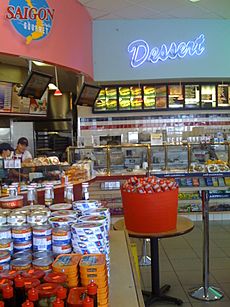
Prior to the Fall of Saigon in 1975, well-known South Vietnamese bánh mì vendors included Bánh mì Ba Lẹ and Bánh mì Như Lan (which opened in 1968).
In regions of the United States with significant populations of Vietnamese Americans, numerous bakeries and fast food restaurants specialize in bánh mì. Lee's Sandwiches, a fast food chain with locations in several states, specializes in Vietnamese sandwiches served on French baguettes (or traditional bánh mì at some locations) as well as Western-style sandwiches served on croissants. In New Orleans, Dong Phuong Oriental Bakery is known for the bánh mì bread that it distributes to restaurants throughout the city. After 1975, Ba Lẹ owner Võ Văn Lẹ fled to the United States and, along with Lâm Quốc Thanh, founded Bánh mì Ba Lê. The Eden Center shopping center in Northern Virginia has several well-known bakeries specializing in bánh mì.
Mainstream fast food chains have also incorporated bánh mì and other Vietnamese dishes into their portfolios. Yum! Brands operates a chain of bánh mì cafés called Bánh Shop. The former Chipotle-owned ShopHouse Southeast Asian Kitchen chain briefly sold bánh mì. Jack in the Box offers a "bánh mì–inspired" fried chicken sandwich as part of its Food Truck Series. McDonald's and Paris Baguette locations in Vietnam offer bánh mì.
Images for kids
See also
 In Spanish: Bánh mì para niños
In Spanish: Bánh mì para niños



